Finding a home in the Italian countryside: A survivors' guide
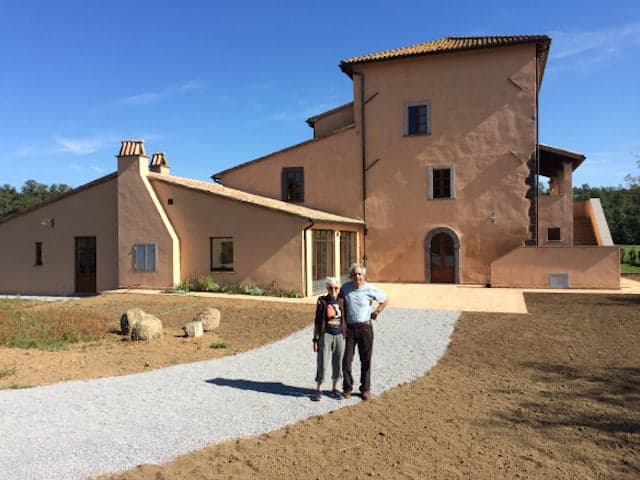
What happens when you make your dream of buying a house in rural Italy a reality? For two couples, it took ten years and hundreds of thousands of euros. Rome-based writer John Henderson heard their story, and shares their advice.
It didn’t all start with Frances Mayes.
Yes, her 1996 blockbuster Under the Tuscan Sun made owning a house in the Italian countryside seem like nirvana with better food. But mankind has sought Italy’s rolling green hills, vast meadows and sunny skies ever since the Ancient Roman aristocracy built villas in the Alban Hills outside Rome.
The idea of rural Italy has passed through the minds of anyone who is overworked, under-loved and out of breath. For those blessed to visit, love for this country sometimes turns dreams into plans.
READ ALSO: How Under the Tuscan Sun changed a small Italian town
For Gretchen, 75, and Peter Bloom, 79, and for Beth Blosser, 59, and Stefano Carta, 58, their dreams have become reality. I know. I’m standing in the middle of that dream. I’m in the spacious living room — I think. Wait, maybe it’s the sun room. The guest apartment? I can’t really tell. Their renovated home in the Italian countryside is an 800-square-meter, 29-room palace with seven bedrooms and seven bathrooms. It has more balconies than St Peter’s.
It has four kitchens, two spiral staircases, a conference room, an office, four fireplaces and three floors — not counting a loft that can sleep ten. It has separate structures to make wine and pizza, for God’s sake. All that’s missing is a swimming pool.
That’s next.
Technically speaking, it’s called a casale. That’s Italian for farmhouse. Built in the mid-1800s and christened Festina Lente ('Make haste slowly'), it was used for farming livestock until the 1950s.

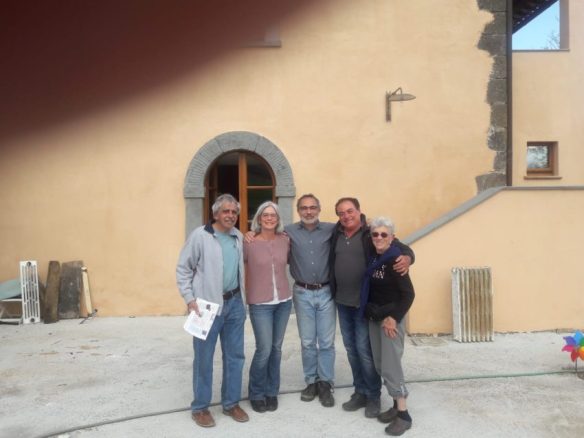
From left: Peter Bloom, Gretchen Bloom, Emma Carta, Stefano Carta, Beth Blosser. Photo: Stefano Carta
Today, it is the stone, mortar and tile love child of two couples who lived for years in the same building in Rome near the Colosseum. If your daily monotony has been invaded by thoughts of sipping Chianti on your own sunny patio looking at grazing sheep in a quiet green meadow, listen to their story.
It’s a tale that has taken a decade of broken promises, laughable cost estimates, falling walls and haemorrhaging money. They’ve experienced tears, screams, sweat and endless sleepless nights. But today, ten years later? They’re sipping Chianti on their sunny patio looking at grazing sheep in a quiet green meadow.
FOR MEMBERS:
-
How to stay out of trouble when renovating your Italian property
-
Why 2020 will be a good year to buy and renovate a home in an Italian city
-
The ups and downs of buying a property for retirement in a hilltop village in Italy
Their goals and barriers are similar to those of all dreamers. Just keep in mind this project is a gross exaggeration of the average house in the Italian countryside. The foursome bought the house in 2008 for €400,000. How much have they put into it? At least €1 million.

“If you want to ask if this was rational? Absolutely not,” Peter Bloom says. “No way. I don’t think we had an idea how big this was. There were times three or four years in when I didn’t know what floor I was on or what room I was in.”
Festina Lente is located between the town of Bagnoregio and the pretty medieval lakeside town of Bolsena near the lightly trodden border between Lazio and Umbria. Just 90 minutes from Rome, it seems like 90 years from Rome’s problems.
“All they wanted was a little house in the country,” Bloom says. “The origin of this is just a classic Italian couple. Everybody wants just a little place in the country. I mean little.”

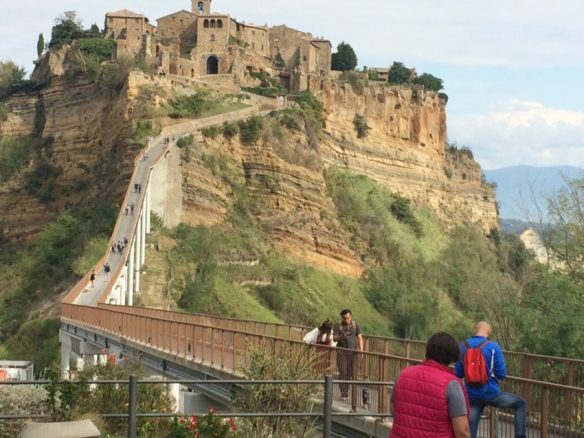
Civita di Bagnoregio, a walled village a short drive from Festina Lente. Photo: John Henderson
How this happened is a combination of one couple’s dream and another’s generosity. It all started more than ten years ago when Beth and Stefano had a 150-square-meter country house sold out from under them. Seeing their friends devastated, the Blooms offered to go in with them on another search.
They found a 200-square-meter place near Todi, across the border in Umbria, but the Blooms didn’t like the long dirt road in or the 67 acres of fields and woods on the property. In the meantime, Beth’s and Stefano’s 10-year-old daughter, Emma, was surfing the internet. She came across this big stone house on seven acres of land in northern Lazio.
Perfect. The deal was signed. Now all they had to do was renovate.
READ ALSO:
-
Expert tips on renovating your Italian property
-
How and where to find your dream renovation property in Italy
-
'How we renovated an apartment in a historic Bologna palazzo'
Ahem, this is when dream becomes reality, the wrong kind of reality, when nightmares don’t only come when you’re sleeping. They received some horribly bad advice. A Rome architect told them the roofs were fine and sturdy. They weren’t. They had to be replaced. All four roofs cost €40,000 each.
The roofs also needed chimneys. They had to drill a well 130 meters into the ground to get water. That was €8,000. The original stone structure may have looked classic but it was faulty. It had to be plastered over and painted. The ground floor was rubble. There was no staircase connecting it to the first floor. Rusting, old farm equipment was strewn around the lawn as if left over from a fire. Only the top floor was liveable.
“You can’t imagine what wasn’t here,” Bloom says.

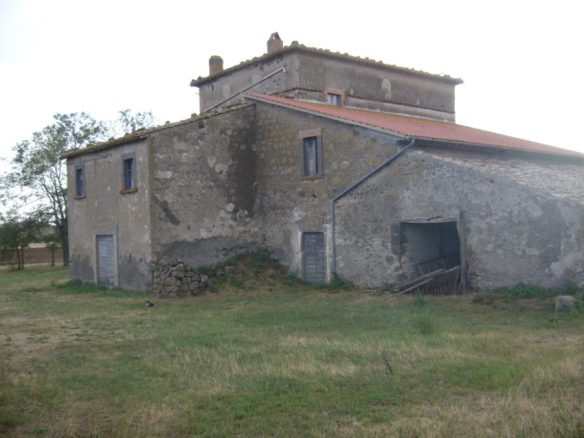
Festina Lente when it was first purchased in 2008. Photo: Stefano Carta
And in the winter, at 600 meters, it is freezing. Stefano found out the hard way how heat is exasperated in huge stone houses. He stayed ten days one winter and the heating bill came out to €500.
It got worse. In 2008 the US banking crisis also hit. The Blooms had all their money in the stock market and at one time were tempted to leave Rome for the US. But instead of bailing, Peter took out loans and the foursome continued hammering away. Stefano made countless trips north to monitor the progress.
READ ALSO: How not to buy a house in Italy: The top mistakes to avoid
All the time, the Blooms rejected sanity. They weren’t scared of investing in an 8,600-square-foot farmhouse in the midst of a financial crisis that nearly crippled their country. “Eh!” Gretchen says. “We were concerned. We might have to leave Italy, but we were already committed.”
The Blooms split half of every year in their condos in Newport, Rhode Island, and on DuPont Circle in Washington. While the Blooms were in the States, Stefano and Beth kept rolling with the major renovations while travelling around putting their own personal touches on the place.
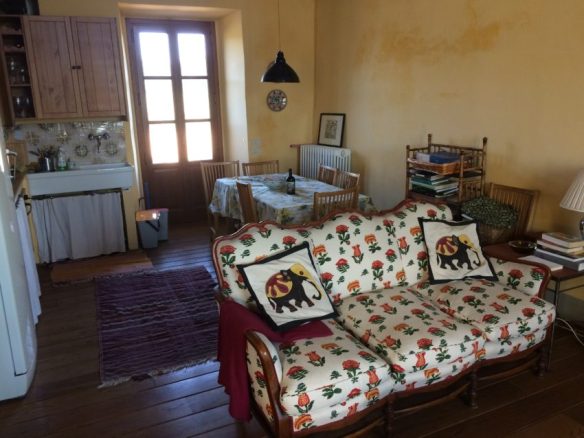
The second-floor apartment. Photo: John Henderson
They found bathroom tiles from Morocco and kitchen tiles from Sicily. They found a parquet floor from Croatia. They worked with an Umbrian artist to design a mosaic floor tile of clouds and a snail. They found a blacksmith in Caserta in southern Italy who made the towel racks with a Tuscan design.
They ordered another towel rack from the United Kingdom. They had the new chimneys made in the same ancient style as seen around the region. Beth, who does garden tours of Rome’s Villa Borghese park, planted 60 ancient fruit trees on the grounds.
READ ALSO: The real cost of buying a house in Italy as a foreigner
I ask Beth, a native of Kent, Ohio, who has lived in Rome since 1987, if it was worth it.
“If you asked me a year ago, I might not have been so much,” she says. “Now that we see the light at the end of the tunnel? Absolutely.”
Peter gives me a tour of the place. It is a long tour. The kitchen has a fireplace — for cooking. The dining table is solid marble. “Four people couldn’t lift that table,” Bloom says. The kitchen cabinets are antique with wrought-iron handles, found on eBay, to hang pots and pans. An antique clock hangs on the wall.

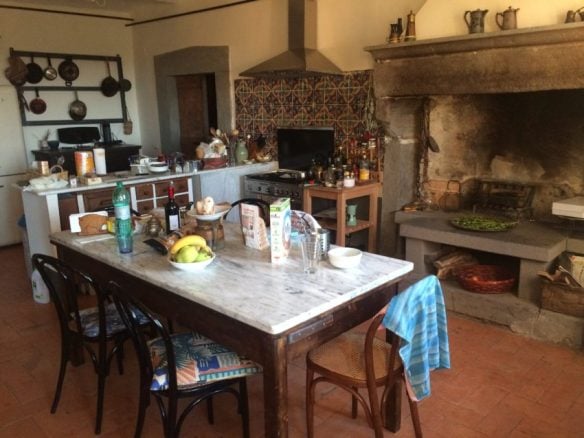
The kitchen. Photo: John Henderson
The living room is made up of the Blooms’ old furniture which came amongst the 84 boxes they sent up from Rome. The hallway has Stefano and Beth’s bedroom which looks like a honeymoon suite at a Four Seasons. While the whole place looks pulled from a 19th-century romance novel, the bathrooms are all modern with bathtubs and walk-in showers.
Every room I enter, even my modest guest room, has great views. “Every view is beautiful,” Bloom says, “and every view sees nothing.”
We walk down into a long airy room lined with floor-to-ceiling windows. We look at the vast farmland beyond. We don’t see another structure. This is their sun room, perfect for sipping wine, brandy or a good book in winter. The windows can fold open in summer.

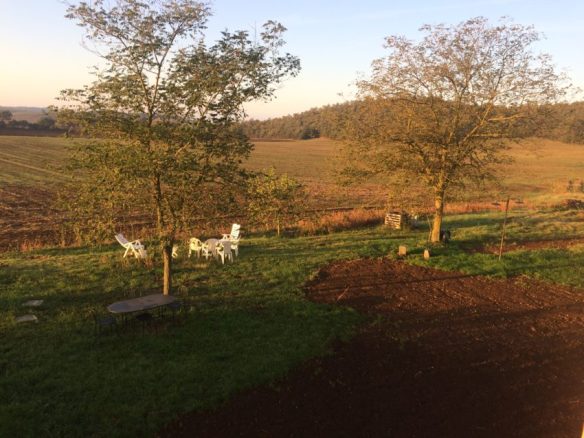
The view from the front door. Photo: John Henderson
We go down to the ground floor which has an entire apartment, complete with couch, love seat, dining room and coffee kitchen — all of which can serve the massive conference room next door through a window in the wall. A bigger kitchen is planned.
We walk outside where he shows me the wine press and the small hut where they hope to make pizzas some day. There’s a fountain “for no good reason,” he says. He stops talking. We listen. We can’t hear a thing. The only sound is an odd rhythmic whacking of what may be a piece of farm equipment far away.
“This is in the middle of nowhere,” he says. “I’ve stayed in a number of agroturismos in Italy and other places and I’ve never been anywhere where you can’t hear something. Some road, somewhere. Or some factory, somewhere. Here…?”

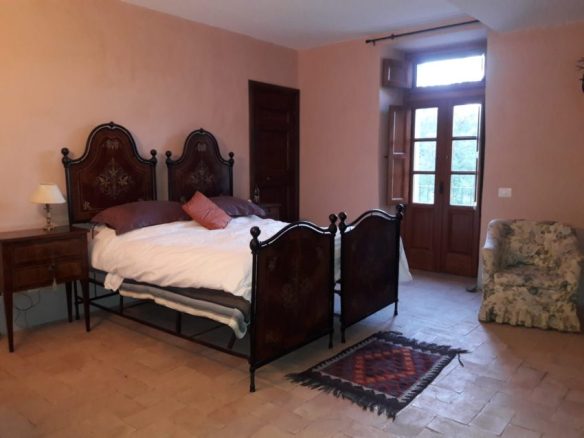
The master bedroom. Photo: John Henderson
We walk up to the second floor where the Blooms were sequestered for eight and a half years of visits while the rest of the house caught up. It’s another entire apartment with a cast-iron fireplace, decorative couch, a dining room table and rustic wooden floor. Upstairs is an open loft, perfect to flop a dozen mattresses for all the grandkids.
That was much of the Blooms’ motivation in this project. They will leave it to their children, who have already had longish stays, at least long enough to know one floor from another, something I couldn’t accomplish in two days.
“My hope is them and their grandkids will come here and spend summers,” Bloom says. “Will they? I may never know. My hope is, as this went on, wouldn’t our kids rather have this lovely place in the countryside of Italy rather than just being left some money?”
FOR MEMBERS:
-
House-hunting in Italy: the essential vocabulary you'll need
-
How safe is living in the Italian countryside?
-
Italian property problems: Why do ten strangers own my bathroom?
OK, so who can relate to an 8,600-square-foot farmhouse? It doesn’t matter. This foursome can relate to you. Anyone who searches for their dream home in Italy has the same guidelines, regardless of need.
So if you haven’t lost hope, here are their five best pieces of advice in finding a country home in Italy.
1. “Don’t do it without an Italian partner,” Bloom says. “Don’t even think about it. You’ll get ripped off six different ways and you won’t know what you’re doing and, unless your Italian is perfect and you know building and land and you’ve done this somewhere else, you’ll get screwed.” Stefano filled the bill here.
2. Ask yourself serious questions. Says Bloom: “Why do you want it? How often will you use it? Is it for you or your family? How often would you come? Is it really worth it to you? They need to know why they’re doing it.”
3. Make sure you can renovate it. The Italian bureaucracy is beyond confusing. It’s easier to build a stadium in the US than a newsstand in Italy. The building restrictions are mind numbing. Also, different regions have different restrictions. Lazio’s are more lax. If this casale was a pizza-toss away across the border in Umbria, half the renovations could not have happened.
4. You’d better be able to afford it. As the Blooms learned, prices can be four times more than you expected. In the US, Bloom says, builders “are realistic.”
5. When you get an estimate, get it from a local. Their first architect who came up from Rome gave them costs that were ridiculously low. No, the roofs were not fine. “No question, had we gotten an estimate from the local builder we now have, we would not have bought it,” Bloom says.
However, they’re glad they did. The commitment took ten years but now they have many years to enjoy it.

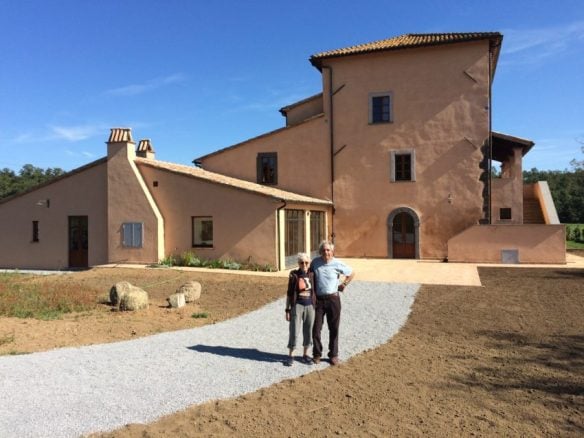
Gretchen and Peter Bloom outside the farmhouse as it looks today. Photo: John Henderson
And they have plans. Beth already has a group of 24 guests lined up sometime next year for their trial rental run. Bloom said if they take four couples, each with their own room, “You could easily rent that floor for €5,000 a week. That’s cheap.” It comes out to less than €90 per person per night, much less than your average agroturismo.
But the biggest event is already planned. In June 2020 the casale will host the Blooms’ 50th wedding anniversary. They are inviting half of Washington and half of Rome.
I think they’ll have room.
John Henderson is a writer and expat living in Rome. This is an edited version of an article that was originally published on his blog, Dog-Eared Passport. Find more of his stories here.
Want to write a guest blog for The Local Italy? Get in touch at [email protected].
Comments (1)
See Also
It didn’t all start with Frances Mayes.
Yes, her 1996 blockbuster Under the Tuscan Sun made owning a house in the Italian countryside seem like nirvana with better food. But mankind has sought Italy’s rolling green hills, vast meadows and sunny skies ever since the Ancient Roman aristocracy built villas in the Alban Hills outside Rome.
The idea of rural Italy has passed through the minds of anyone who is overworked, under-loved and out of breath. For those blessed to visit, love for this country sometimes turns dreams into plans.
READ ALSO: How Under the Tuscan Sun changed a small Italian town
For Gretchen, 75, and Peter Bloom, 79, and for Beth Blosser, 59, and Stefano Carta, 58, their dreams have become reality. I know. I’m standing in the middle of that dream. I’m in the spacious living room — I think. Wait, maybe it’s the sun room. The guest apartment? I can’t really tell. Their renovated home in the Italian countryside is an 800-square-meter, 29-room palace with seven bedrooms and seven bathrooms. It has more balconies than St Peter’s.
It has four kitchens, two spiral staircases, a conference room, an office, four fireplaces and three floors — not counting a loft that can sleep ten. It has separate structures to make wine and pizza, for God’s sake. All that’s missing is a swimming pool.
That’s next.
Technically speaking, it’s called a casale. That’s Italian for farmhouse. Built in the mid-1800s and christened Festina Lente ('Make haste slowly'), it was used for farming livestock until the 1950s.


From left: Peter Bloom, Gretchen Bloom, Emma Carta, Stefano Carta, Beth Blosser. Photo: Stefano Carta
Today, it is the stone, mortar and tile love child of two couples who lived for years in the same building in Rome near the Colosseum. If your daily monotony has been invaded by thoughts of sipping Chianti on your own sunny patio looking at grazing sheep in a quiet green meadow, listen to their story.
It’s a tale that has taken a decade of broken promises, laughable cost estimates, falling walls and haemorrhaging money. They’ve experienced tears, screams, sweat and endless sleepless nights. But today, ten years later? They’re sipping Chianti on their sunny patio looking at grazing sheep in a quiet green meadow.
FOR MEMBERS:
- How to stay out of trouble when renovating your Italian property
- Why 2020 will be a good year to buy and renovate a home in an Italian city
- The ups and downs of buying a property for retirement in a hilltop village in Italy
Their goals and barriers are similar to those of all dreamers. Just keep in mind this project is a gross exaggeration of the average house in the Italian countryside. The foursome bought the house in 2008 for €400,000. How much have they put into it? At least €1 million.

“If you want to ask if this was rational? Absolutely not,” Peter Bloom says. “No way. I don’t think we had an idea how big this was. There were times three or four years in when I didn’t know what floor I was on or what room I was in.”
Festina Lente is located between the town of Bagnoregio and the pretty medieval lakeside town of Bolsena near the lightly trodden border between Lazio and Umbria. Just 90 minutes from Rome, it seems like 90 years from Rome’s problems.
“All they wanted was a little house in the country,” Bloom says. “The origin of this is just a classic Italian couple. Everybody wants just a little place in the country. I mean little.”


Civita di Bagnoregio, a walled village a short drive from Festina Lente. Photo: John Henderson
How this happened is a combination of one couple’s dream and another’s generosity. It all started more than ten years ago when Beth and Stefano had a 150-square-meter country house sold out from under them. Seeing their friends devastated, the Blooms offered to go in with them on another search.
They found a 200-square-meter place near Todi, across the border in Umbria, but the Blooms didn’t like the long dirt road in or the 67 acres of fields and woods on the property. In the meantime, Beth’s and Stefano’s 10-year-old daughter, Emma, was surfing the internet. She came across this big stone house on seven acres of land in northern Lazio.
Perfect. The deal was signed. Now all they had to do was renovate.
READ ALSO:
- Expert tips on renovating your Italian property
- How and where to find your dream renovation property in Italy
- 'How we renovated an apartment in a historic Bologna palazzo'
Ahem, this is when dream becomes reality, the wrong kind of reality, when nightmares don’t only come when you’re sleeping. They received some horribly bad advice. A Rome architect told them the roofs were fine and sturdy. They weren’t. They had to be replaced. All four roofs cost €40,000 each.
The roofs also needed chimneys. They had to drill a well 130 meters into the ground to get water. That was €8,000. The original stone structure may have looked classic but it was faulty. It had to be plastered over and painted. The ground floor was rubble. There was no staircase connecting it to the first floor. Rusting, old farm equipment was strewn around the lawn as if left over from a fire. Only the top floor was liveable.
“You can’t imagine what wasn’t here,” Bloom says.


Festina Lente when it was first purchased in 2008. Photo: Stefano Carta
And in the winter, at 600 meters, it is freezing. Stefano found out the hard way how heat is exasperated in huge stone houses. He stayed ten days one winter and the heating bill came out to €500.
It got worse. In 2008 the US banking crisis also hit. The Blooms had all their money in the stock market and at one time were tempted to leave Rome for the US. But instead of bailing, Peter took out loans and the foursome continued hammering away. Stefano made countless trips north to monitor the progress.
READ ALSO: How not to buy a house in Italy: The top mistakes to avoid
All the time, the Blooms rejected sanity. They weren’t scared of investing in an 8,600-square-foot farmhouse in the midst of a financial crisis that nearly crippled their country. “Eh!” Gretchen says. “We were concerned. We might have to leave Italy, but we were already committed.”
The Blooms split half of every year in their condos in Newport, Rhode Island, and on DuPont Circle in Washington. While the Blooms were in the States, Stefano and Beth kept rolling with the major renovations while travelling around putting their own personal touches on the place.

The second-floor apartment. Photo: John Henderson
They found bathroom tiles from Morocco and kitchen tiles from Sicily. They found a parquet floor from Croatia. They worked with an Umbrian artist to design a mosaic floor tile of clouds and a snail. They found a blacksmith in Caserta in southern Italy who made the towel racks with a Tuscan design.
They ordered another towel rack from the United Kingdom. They had the new chimneys made in the same ancient style as seen around the region. Beth, who does garden tours of Rome’s Villa Borghese park, planted 60 ancient fruit trees on the grounds.
READ ALSO: The real cost of buying a house in Italy as a foreigner
I ask Beth, a native of Kent, Ohio, who has lived in Rome since 1987, if it was worth it.
“If you asked me a year ago, I might not have been so much,” she says. “Now that we see the light at the end of the tunnel? Absolutely.”
Peter gives me a tour of the place. It is a long tour. The kitchen has a fireplace — for cooking. The dining table is solid marble. “Four people couldn’t lift that table,” Bloom says. The kitchen cabinets are antique with wrought-iron handles, found on eBay, to hang pots and pans. An antique clock hangs on the wall.


The kitchen. Photo: John Henderson
The living room is made up of the Blooms’ old furniture which came amongst the 84 boxes they sent up from Rome. The hallway has Stefano and Beth’s bedroom which looks like a honeymoon suite at a Four Seasons. While the whole place looks pulled from a 19th-century romance novel, the bathrooms are all modern with bathtubs and walk-in showers.
Every room I enter, even my modest guest room, has great views. “Every view is beautiful,” Bloom says, “and every view sees nothing.”
We walk down into a long airy room lined with floor-to-ceiling windows. We look at the vast farmland beyond. We don’t see another structure. This is their sun room, perfect for sipping wine, brandy or a good book in winter. The windows can fold open in summer.


The view from the front door. Photo: John Henderson
We go down to the ground floor which has an entire apartment, complete with couch, love seat, dining room and coffee kitchen — all of which can serve the massive conference room next door through a window in the wall. A bigger kitchen is planned.
We walk outside where he shows me the wine press and the small hut where they hope to make pizzas some day. There’s a fountain “for no good reason,” he says. He stops talking. We listen. We can’t hear a thing. The only sound is an odd rhythmic whacking of what may be a piece of farm equipment far away.
“This is in the middle of nowhere,” he says. “I’ve stayed in a number of agroturismos in Italy and other places and I’ve never been anywhere where you can’t hear something. Some road, somewhere. Or some factory, somewhere. Here…?”


The master bedroom. Photo: John Henderson
We walk up to the second floor where the Blooms were sequestered for eight and a half years of visits while the rest of the house caught up. It’s another entire apartment with a cast-iron fireplace, decorative couch, a dining room table and rustic wooden floor. Upstairs is an open loft, perfect to flop a dozen mattresses for all the grandkids.
That was much of the Blooms’ motivation in this project. They will leave it to their children, who have already had longish stays, at least long enough to know one floor from another, something I couldn’t accomplish in two days.
“My hope is them and their grandkids will come here and spend summers,” Bloom says. “Will they? I may never know. My hope is, as this went on, wouldn’t our kids rather have this lovely place in the countryside of Italy rather than just being left some money?”
FOR MEMBERS:
- House-hunting in Italy: the essential vocabulary you'll need
- How safe is living in the Italian countryside?
- Italian property problems: Why do ten strangers own my bathroom?
OK, so who can relate to an 8,600-square-foot farmhouse? It doesn’t matter. This foursome can relate to you. Anyone who searches for their dream home in Italy has the same guidelines, regardless of need.
So if you haven’t lost hope, here are their five best pieces of advice in finding a country home in Italy.
1. “Don’t do it without an Italian partner,” Bloom says. “Don’t even think about it. You’ll get ripped off six different ways and you won’t know what you’re doing and, unless your Italian is perfect and you know building and land and you’ve done this somewhere else, you’ll get screwed.” Stefano filled the bill here.
2. Ask yourself serious questions. Says Bloom: “Why do you want it? How often will you use it? Is it for you or your family? How often would you come? Is it really worth it to you? They need to know why they’re doing it.”
3. Make sure you can renovate it. The Italian bureaucracy is beyond confusing. It’s easier to build a stadium in the US than a newsstand in Italy. The building restrictions are mind numbing. Also, different regions have different restrictions. Lazio’s are more lax. If this casale was a pizza-toss away across the border in Umbria, half the renovations could not have happened.
4. You’d better be able to afford it. As the Blooms learned, prices can be four times more than you expected. In the US, Bloom says, builders “are realistic.”
5. When you get an estimate, get it from a local. Their first architect who came up from Rome gave them costs that were ridiculously low. No, the roofs were not fine. “No question, had we gotten an estimate from the local builder we now have, we would not have bought it,” Bloom says.
However, they’re glad they did. The commitment took ten years but now they have many years to enjoy it.


Gretchen and Peter Bloom outside the farmhouse as it looks today. Photo: John Henderson
And they have plans. Beth already has a group of 24 guests lined up sometime next year for their trial rental run. Bloom said if they take four couples, each with their own room, “You could easily rent that floor for €5,000 a week. That’s cheap.” It comes out to less than €90 per person per night, much less than your average agroturismo.
But the biggest event is already planned. In June 2020 the casale will host the Blooms’ 50th wedding anniversary. They are inviting half of Washington and half of Rome.
I think they’ll have room.
John Henderson is a writer and expat living in Rome. This is an edited version of an article that was originally published on his blog, Dog-Eared Passport. Find more of his stories here.
Want to write a guest blog for The Local Italy? Get in touch at [email protected].
Join the conversation in our comments section below. Share your own views and experience and if you have a question or suggestion for our journalists then email us at [email protected].
Please keep comments civil, constructive and on topic – and make sure to read our terms of use before getting involved.
Please log in here to leave a comment.